
NOW Articles Written By Members
A look back at a common, but classic commemorative – Wisconsin’s Territorial Centennial
A side-tracked story: Mardi Gras Doubloons
A look back at a collecting specialty – the O.P.A. ration tokens of WWII
Bullion And Coin Tax Exemption – Act Now!
Is There A Twenty Cent Piece We Can Add To A Collection
Capped Bust Half Dollars: A Numismatic Legacy
U.S. Innovation Dollars: Our Most Under-Collected Coin?
My 2023 ANA Summer Seminar Adventure
In defense of the American Women's Quarters
A look back in numismatic history – the Hicksville Silver Dollar Hoard
The proofs so few of us collect: Jefferson Nickels
A look back in numismatic history – a story too good to be true
Kilroy promotes war bond sales
Just passing through a short-lived bank
The Kewaunee Line Encased Coin Folder
Lyman C. Draper: Collector, Historian, Genealogist
>> More articles in the Archive
For more NOW Articles Written By Members,
<< More articles in the Archive
Old Abe and the “General”
[by Gene Johnson #105L]
The soulful presidency of Abraham Lincoln, which encompassed the Civil War, is a sad documentary of failed union army generals. Among these were the unskilled politicos, the over-cautious career men, and those with no stomach for battle.
Most Civil War buffs can name the more successful union army brass -- General Grant, General Sherman and General Thumb… You say you never heard of General Thumb? Well, maybe that’s because “General Tom Thumb” was the creation of pitchman Phienas T. Barnum, who in the years 1844-1853 turned a 6-year old midget named Charles Sherwood Stratton into a famous 15-year old international attraction at his “American Museum” in New York City.
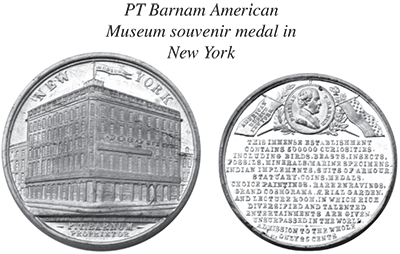
The “American Museum” was a combination curiosity collection and carnival type freak show (including a giant) that on another Barnum advertising token, claimed to hold a half million odd and curious items, including coins, medals, Indian artifacts, art, etc.. The cost of admission was two bits.
Somehow the slick pitchman was able to talk Charles’ parents into letting him take control of the bright little guy at six years of age. This may have reflected on the economic time period and the fact that both of his parents were of normal size.
How Barnum came up with the “General Tom Thumb” title for the midget, no one seems to know, but in 1863 at the age of 24, the “General” really did play a role in Abe Lincoln’s Civil War.
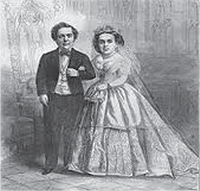 Charles “Tom Thumb” Stratton, (1838-1883) had married early in 1863, and P.T. Barnum, in a masterful stroke of publicity, brought him and his midget wife to Lincoln’s White House for a gala event where the tiny couple was a bright spot in the nation’s dismal, dejected and dusty wartime capital. In his 1957 book “Mr. Lincoln’s Washington,” author Stanley Kimmel described the event:
Charles “Tom Thumb” Stratton, (1838-1883) had married early in 1863, and P.T. Barnum, in a masterful stroke of publicity, brought him and his midget wife to Lincoln’s White House for a gala event where the tiny couple was a bright spot in the nation’s dismal, dejected and dusty wartime capital. In his 1957 book “Mr. Lincoln’s Washington,” author Stanley Kimmel described the event:
“The “General” wore a full suit of black, patent leather boots, a faultless necktie, a large breast pin of brilliants, a gold watch with elaborate chain, and a pair of snow white kid gloves. His diminutive wife was gowned in rich white satin, sprinkled with green leaves and looped with carnation buds, with a necklace, cluster pin, and bracelets of sparkling diamonds unmatched by any woman attending the affair. Lincoln remarked to the “General” that he had put the president of the United States “completely in the shade” for since his arrival in the capital he had been “the greater center of attraction.”
At the time of the White House visit, Tom was 32” tall and weighed 21 pounds. His bride was about the same height and a tad heavier.
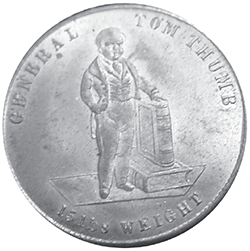 The tiny couple were later serenaded in a ball at their hotel by the Goodall’s Capital Band, before returning to Philadelphia the next day.
The tiny couple were later serenaded in a ball at their hotel by the Goodall’s Capital Band, before returning to Philadelphia the next day.
There is little doubt that the illustrated token was part of the famous P.T. Barnum “ballyhoo.”
The obverse of the Spielmark type token depicts the midget at age 15, nine years before his Civil War time marriage. It uses two books, one standing on end, to dramatize the “General’s” tiny size, only 25 inches in height and weighing 15 pounds.
This token, Rulau (NY NY-19) is one of two different types tokens struck in England remembering Tom Thumb listed in the 2004 token book. Russ Rulau dates the token (Ca. 1852) based on the General’s size and weight at that time. Not considered rare, the brass token is catalogued at $30.00 in uncirculated condition.
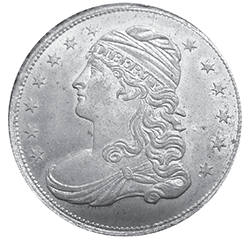 The striking of this General Tom Thumb token is interesting. The reverse die closely resembles the obverse of the U.S. 1831-1838 quarter dollar, but seems unrelated to that issue period.
The striking of this General Tom Thumb token is interesting. The reverse die closely resembles the obverse of the U.S. 1831-1838 quarter dollar, but seems unrelated to that issue period.
Tom Thumb souvenir pieces were struck in England as late as 1881, two years before his death.
The war between the states has hundreds of fascinating stories to tell, but most dwell on the bloody conflict, and ignore the desperate civilian lives and times surrounding our revered and martyred president, Abraham Lincoln.
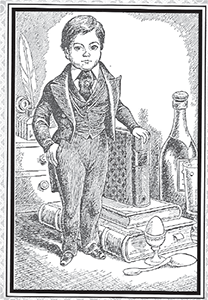 |
References: Kimmel, Stanley – “Mr. Lincoln’s Washington” Rulau, Russell-Standard Catalog of United States Tokens 1700-1900. World Book Encyclopedia |
“Tom Thumb”, a book written by George Sullivan, offeres additional insights about this remarkable little man.
Charles Sherwood Stratton, was born January 4, 1838, to parents, who were of medium height. He weighed 9 pounds 8 ounces and developed normally for the first 6 months of his life.
“Charley” made his first tour of America at the age of five, with routines that included impersonating characters such as Cupid, and Napoleon Bonaparte as well as singing, dancing and comical banter. A year later he toured Europe and appeared twice before Queen Victoria. He also met the 3-year old Prince of Wales, who would become King Edward VII.
Under Barnum’s management, Stratton became a wealthy man. He owned a house in the fashionable part of New York, had a steam yacht, and had a wardrobe of fine clothes. He also had a specially adapted home in one of Connecticut’s Thimble Islands. When Barnum got into financial difficulty, Stratton bailed him out and lthey ater became business partners.
Stratton made his final appearance in England in 1878. The ”General” died of a stroke on July 15, 1883 (age 45), with over 10,000 people attending his funeral. 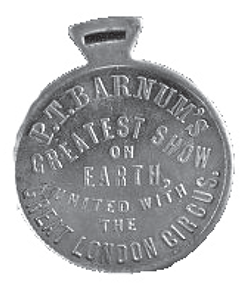 P.T. Barnum purchased a life-size statue of Tom Thumb and placed it as a grave stone at Mountain Grove Cemetery in Bridgeport, Connecticut.
P.T. Barnum purchased a life-size statue of Tom Thumb and placed it as a grave stone at Mountain Grove Cemetery in Bridgeport, Connecticut.
P.T. Barnum 1881 Greatest Show on Earth souvenir fob honors Chang, who was nearly 8’ tall, truely a giant for his time.
Circus World Museum Aquires a New Artifact
When crews were renovating a downtown Madison bar last month, they discovered a wall of old barn boards covered with a poster for the P.T. Barnum Greatest Show on Earth and the Great London Circus that dates back to August 1886 when the show came to Madison. 24 boards, which came in 4, 8 & 12’ sections, were carefully wrapped in tissue paper and transported to Baraboo. (Wisconsin State Journal ).
Have an interesting numismatic topic you’d like to share with your fellow NOW members?
Send your article to evan.pretzer@protonmail.com today!!!